To access the rest of the concept sheets in the unit on Energy-producing Regions, consult the See Also section.
In geography, an issue is a problem related to land use and development. The issue may be related to environmental, economic, political, social or other aspects.
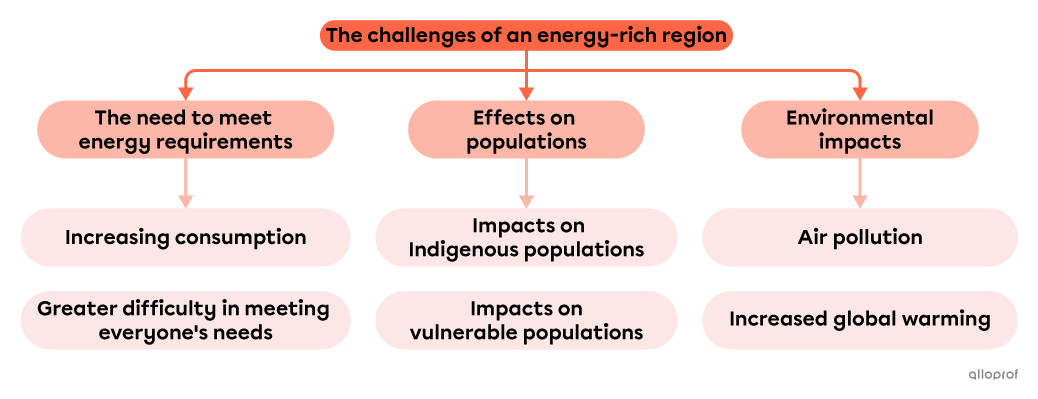
Every country needs energy to support its development and activities. However, it can be difficult to meet the energy needs of the population and industry, especially as energy demand tends to increase. Various solutions must therefore be put in place.
Energy demand is increasing almost everywhere in the world. The main reason for this increase is that the world's population and economy are growing. In other words, this means that there are more people and industries on the planet, and therefore greater energy requirements.

Exajoule is a unit of energy measurement.
Data source: International Energy Agency, 2023[1]
Energy consumption per capita is uneven from country to country. Generally speaking, developed countries consume more energy. Rapidly developing countries are also seeing their energy consumption rise rapidly. This is the case, for example, in India and China.
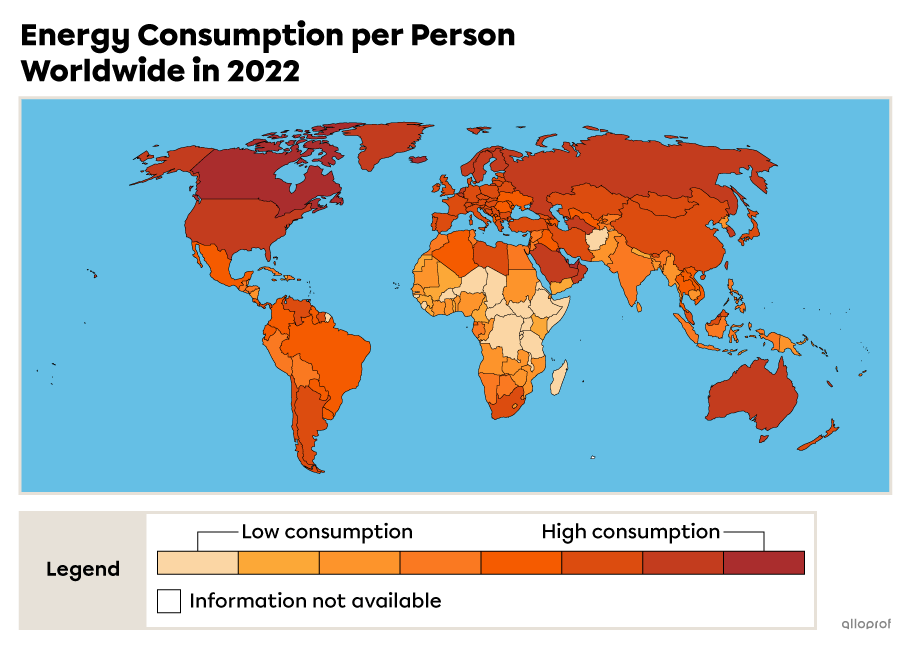
Data source: Our World in Data, 2023[2].
In 2020, Canada's population was the 39th largest in the world. Yet, in terms of electricity consumption per capita, Canada was in 4th position[3]. Several factors explain why it consumes so much electricity. These include the fact that the country covers a vast area and its population is spread over a large territory. Transport needs are therefore greater.
Energy-Intensive Industries
Several energy-intensive industries are present across the country. This is the case, for example, of several major industries in Canada, such as:
-
pulp and paper production
-
oil and gas extraction
-
aluminum production
High Energy Demand for Heating
Canada is one of the coldest countries in the world. In 2021, the average temperature in Canada was 1.6°C[3]. These cold temperatures increase the demand for electricity to heat buildings.
Conversely, in summer, when temperatures are warm, air-conditioning units consume electricity to cool buildings.
Higher Incomes and Affordable Electricity
The price of electricity in Canada is generally lower than in other member countries of the Organization for Economic Co-operation and Development (OECD). Because it's readily available and relatively cheap, people and industries tend to consume more electricity. This use increases overall electricity consumption in the country.
Measures have been put in place over the years to help reduce energy consumption and increase energy efficiency in Canada. The Canadian Green Home grant is one such measure. Eligible homeowners can have their home assessed and identify the work needed to reduce the building's energy consumption. This may involve improving insulation, changing windows or installing a heat pump. They then receive a certain amount of money according to the work carried out to help pay for it.
Between 2000 and 2021, energy consumption in the residential sector rose by 8.4%. It has been calculated that if no measures had been implemented, this increase would have been 36%[4].
It can be difficult for a country to produce enough energy to meet the energy needs of its territory.
In some cases, the difficulty stems from the fact that the country has few energy resources on its territory. In these cases, energy sources have to be imported from other countries, or other means of producing sufficient energy have to be found.
In other cases, energy resources are present in a territory, but the country lacks the infrastructure to exploit, transform and transport them.
-
An infrastructure is a human construction or set of constructions (roads, bridges, buildings, aqueducts, etc.) that make it possible to develop a territory.
-
The gross domestic product (GDP) estimates a country's wealth by calculating the value of goods and services produced in the country during a year.
Nigeria is a country located in West Africa. The demand for electricity is greater than the country's infrastructure is capable of providing. As a result, 43% of the population (around 85 million people) have no access to electricity. Those who do have access to the country's power grid experience several power outages. Around 78% of these people have access to electricity for less than 12 hours a day[5].
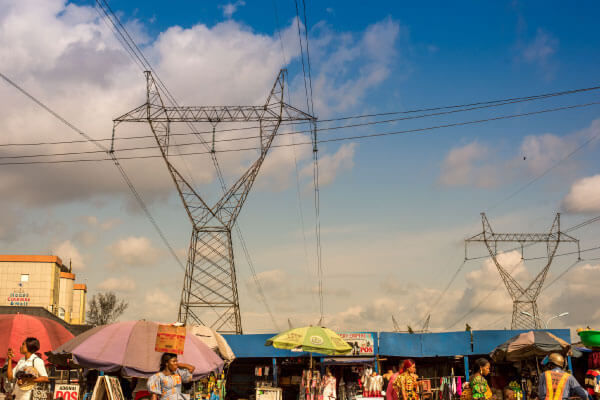
Source : Tolu Owoeye, Shutterstock.com
The government has been trying to remedy the situation for several years. The country sometimes has difficulty obtaining supplies of natural gas, the energy source used to run its thermal power plants. Another part of the problem stems from a lack of transmission and distribution infrastructure for electricity, and a lack of maintenance of this infrastructure.
These energy supply problems have a major impact on Nigeria's GDP. Indeed, its economy is slowed down by this lack of energy. Meanwhile, industries and individuals are equipping themselves with generators to be able to produce their own electricity until a better solution is found.
Generally speaking, there are 2 solutions to energy needs:
-
reduce personal and industrial energy consumption
-
increase energy production
When a country cannot meet its own energy needs, it can import energy from other countries. This can be in the form of fuel or electricity.
Reducing Energy Consumption
Several measures can be put in place to encourage reduction in energy consumption. Some are aimed at individuals, others are more industry-oriented. In all cases, the aim is to achieve the necessary activities using as little energy as possible.
Hydro-Québec is the government corporation responsible for energy production in Quebec. It offers a number of ideas to help people reduce energy consumption at home. These include using appliances such as washing machines and dishwashers when they are full and, in the case of washing machines, washing clothes in cold water.
Another option is to buy appliances such as televisions and refrigerators that are certified to use less energy. Energy Star certification, for example, identifies appliances, buildings and industries that have taken steps to consume less energy. For example, a Energy Star-certified TV can consume up to 27% less energy than one that isn’t[6].

Source : kyiv-top, Shutterstock.com
Increasing Energy Production
To meet energy needs, it is also possible to increase energy production. However, increasing energy production has negative impacts on the environment when it is created from non-renewable resources, such as fossil fuels. These types of energy produce huge quantities of greenhouse gases.
Renewable energies are therefore an attractive option for meeting energy needs while avoiding negative environmental impacts.
Over 80% of the energy consumed worldwide comes from fossil fuels[7]. One consequence of the exploitation and use of fossil fuels is the emission of large quantities of greenhouse gases (GHGs). The GHGs emitted by human activities are mainly carbon dioxide (CO2), methane (CH4) and nitrous oxide (N2O). These gases trap heat in the atmosphere.
The exploitation of fossil fuels generates 75% of global GHG emissions and around 90% of CO2 emissions[7].
Since the period of industrialization, human activities have greatly increased greenhouse gas emissions, contributing in large part to global warming.
-
Some of the sun's rays are reflected by the atmosphere back into space, while others enter the atmosphere.
-
The sun's rays that penetrate the atmosphere reach the earth's surface, which absorbs the energy. Soil and ocean temperatures rise.
-
The energy absorbed by the Earth's surface is then transformed into heat, which is returned to the atmosphere.
-
Some of this heat passes through the atmosphere and back into space.
-
Another part of this heat is retained in the atmosphere by greenhouse gases, raising the temperature of the atmosphere and contributing to global warming.
-
Some of the heat retained by greenhouse gases is radiated back to the Earth's surface.
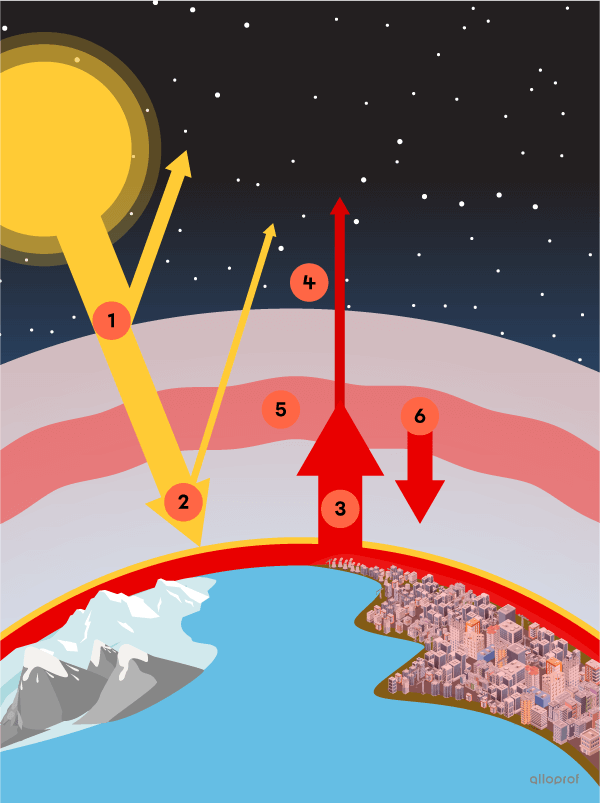
Global warming is the rapid increase in the Earth's average surface temperature that has been observed for many years.
To measure global warming, the annual global mean temperature is measured and compared to the average temperature of the pre-industrial period (1850-1900). In 2022, the global average temperature was 1.15°C higher than the average for the pre-industrial period.
The decade from 2011 to 2020 was the hottest on record. The higher temperatures caused by global warming cause several consequences, such as:
-
an increase in heatwave days
-
intense droughts
-
forest fires
-
flooding
-
ocean warming
-
melting of the ice caps (glacier)
-
more frequent and more intense cyclones and hurricanes
These consequences for the climate have a direct impact on ecosystems and human populations.
-
They lead to the disappearance of species and thus a decline in biodiversity.
-
They worsen the shortage of drinking water.
-
They increase the impact of natural disasters (more human losses and material damage).
-
They reduce agricultural yields.
-
They increase hunger and malnutrition worldwide.
-
They increase the spread of disease.
-
They increase population displacement.
-
They increase the number of deaths.
The Paris Agreement to Limit Global Warming
In 2015, world leaders gathered in Paris for the United Nations Climate Change Conference. It was then that 194 countries agreed and signed the Paris Agreement[8]. This is an international treaty that defines the commitments each country must make in order to reduce greenhouse gas emissions.
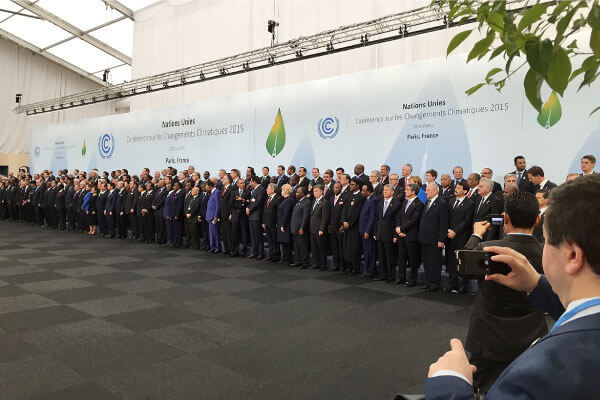
Source : Family photo during the Leader Event of COP21/CMP 11 - Paris Climate Change Conference [Photographie], UNclimatechange, (2015, November 30th), Flickr. (URL). CC BY 2.0[9]
The main goal of the Paris Agreement is to limit global warming to 2°C, since scientists believe that a rise greater than this would have disastrous consequences for the Earth's climate. It would also have major effects on health, and could cause millions of deaths.
The Agreement stresses the importance of limiting the rise in global average temperature to 1.5°C, which would prevent some of the effects of global warming and maintain a sustainable climate.
In addition to greenhouse gases, fossil fuels are also responsible for air pollution through the emission of fine particles.
These microparticles, known as PM2.5, have been classified as carcinogenic by the UN. These micropollutants penetrate deep into the lungs and bloodstream, and can cause respiratory and cardiovascular disease. Around 9 out of 10 people worldwide are exposed to these microparticles[10].
This pollution shortens average life expectancy by 2 years[11]. Some regions of the world are more affected than others. Asia is the continent where the population is most affected since its life expectancy is reduced by more than 4 years as opposed to 8 months in Europe.
According to the World Health Organization (WHO), around 7 million people die every year because of air pollution[12]. In 2018, air pollution from fossil fuels caused more than 8 million premature deaths. This represents 20% of adult deaths worldwide[12]. Half of these deaths are in India and China.
The WHO also published a report in 2018 stating that 93% of all children on the planet are exposed to air pollution every day[13]. For 1.8 billion of these children, the air they breathe is so polluted that it threatens their health and development. Among other things, polluted air can cause acute respiratory tract infections. According to WHO estimates, this type of infection killed 600 000 children in 2016[13].
New Delhi, the capital of India, is one of the most polluted cities in the world. Levels of microparticles in the air are often 30 times higher than the maximum recommended by the WHO[14]. This air pollution causes enormous problems for the city's population of over 30 million.
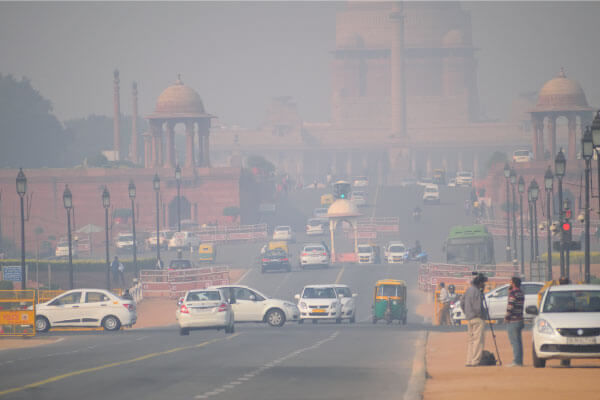
Source : Saurav022, Shutterstock.com
Polluted air can cause eye and skin irritation, asthma, cancer and serious cardiovascular and respiratory diseases. Residents of the capital lose an average of 12 years of life due to air pollution[14]. Children are also particularly vulnerable. About 1 pupil in 3 is said to suffer from asthma or breathing problems[15]. City authorities close schools for several weeks each year when the air quality index is considered too dangerous for children.
Pollution peaks occur in autumn and winter. Some natural factors explain these peaks, such as cold weather and weaker winds that trap pollution. Human factors, however, remain the main culprits behind air pollution in New Delhi:
-
pollution from industries and factories
-
emissions from cars
-
waste incineration
-
farmland fires
-
dependence on fossil fuels for energy production
During October and November, farmers in the regions around the capital burn their farmland to clear the fields for the next crop. It's an inexpensive practice and has been illegal since 2015, but the authorities are having trouble enforcing the ban. According to estimates, farmland fires are responsible for over 40% of the microparticle pollutants in the air[16].
A few temporary solutions have been put in place such as:
-
warnings for highly polluting factories
-
closure of construction sites during pollution peaks
-
temporary reduction in the number of vehicles on the road
-
the ban of fireworks
However, these measures are not enough to permanently reduce air pollution. The authorities need to enforce the ban on crop burning, and the country needs to move away from fossil fuels towards renewable energies.
In 1988, the World Meteorological Organization and the United Nations Environment Programme created the Intergovernmental Panel on Climate Change (IPCC).
The IPCC's mission is to take stock of the situation regarding the evolution of global warming, its impacts and possible solutions. Every 5 to 8 years, the IPCC produces an assessment report on the issue, bringing together all climate-related scientific research and publications.
In its sixth assessment report, published in 2021-2022, the IPCC predicts that the 1.5°C increase limit defined in the Paris Agreement could be reached as quickly as 2025. However, according to the IPCC, there is sufficient global knowledge, technology and capital to reduce the effects of climate warming. The report puts forward several solutions. It also demonstrates that the costs required for climate protection would be less significant than the costs related to the effects of global warming. Moreover, many measures to reduce the effects of global warming would also be beneficial at other levels, such as reducing inequality and hunger in the world, improvements in population health, etc.
The main solution in order to counter and reduce the consequences of global warming is to reduce greenhouse gas emissions rapidly and radically.
Moving From Non-Renewable to Renewable Energies
Since fossil fuels generate the majority of greenhouse gases, the first thing to do is to end the exploitation of these non-renewable energies as quickly as possible and, instead, turn to renewable energies. Renewable energy sources, such as solar and wind power, emit little or no greenhouse gases or air pollutants. Turning to them to meet the planet's energy needs would radically reduce greenhouse gas emissions. According to IPCC studies, the massive development of renewable energies is a necessary element in achieving climate-related goals.
Technological advances in recent years have made it possible to significantly reduce the costs of renewable energies. Between 2010 and 2019, wind energy costs fell by 55%, while solar energy costs dropped by 85%[17]. This makes these types of energy much more accessible to all countries.
Protecting and Restoring Forests
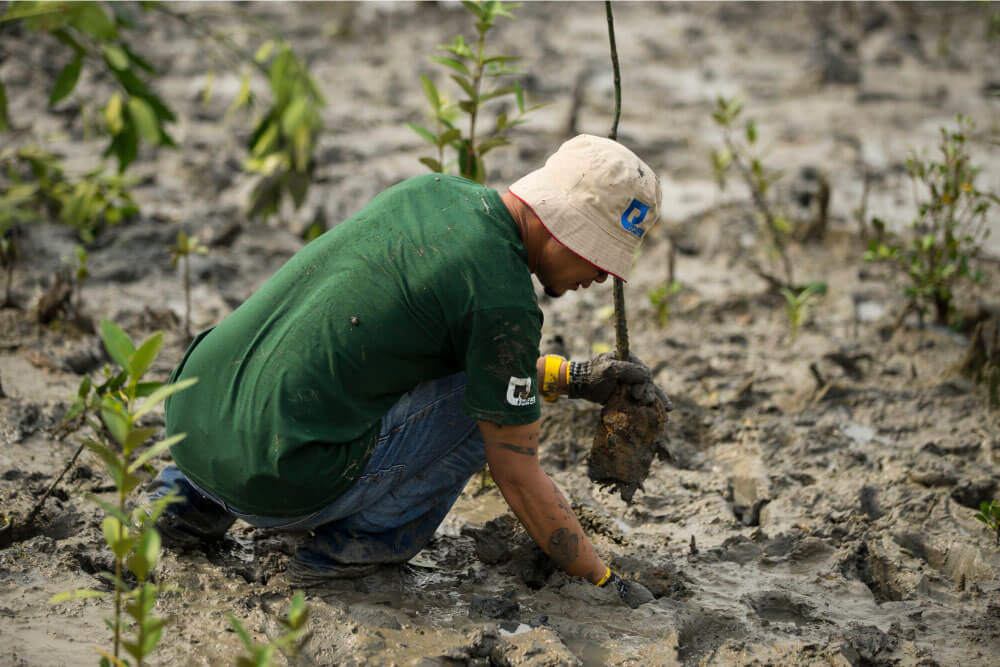
Source : Farid Suhaimi, Shutterstock.com
Forests are often referred to as the lungs of the planet. They help reduce global warming by capturing and storing significant quantities of CO2, one of the main components of greenhouse gases. Restoring forests and natural environments is possible by protecting these environments. Stopping deforestation and planting trees are other possible solutions. This could go a long way towards meeting the objectives of the Paris Agreement.
Changing Our Lifestyles
The IPCC report also indicates that greenhouse gas emissions could be significantly reduced through adjustments to the lifestyles of the world's populations.
One major adjustment is to reduce our consumption. This can be done by:
-
reducing food waste
-
reducing meat consumption
-
buying used goods
-
shopping in thrift stores
These gestures may seem small on an individual level, but on a global scale they can have a major positive impact.
Governments and authorities also need to get involved in order to:
-
improve city planning to encourage walking and cycling
-
invest in a more efficient public transport network
-
encourage local economies to reduce the transportation of goods

The tramway and pedestrian streets in Montpellier, France, are ways of reducing transport-related greenhouse gases.
Source : Mike_O, Shutterstock.com
Adapting to Better Cope With the Consequences of Global Warming
Even if various solutions are put in place, the consequences of global warming are already being felt and are likely to worsen in the coming years. Governments and populations alike must adapt to cope with these changes. These adaptations can take different forms, such as:
-
diversifying agricultural crops to better cope with drought
-
adding vegetation to cities to cope with heat waves
-
adjusting building standards in coastal regions to be better prepared for flooding
-
solidifying roads, bridges and other infrastructure so that they are better adapted to more violent storms
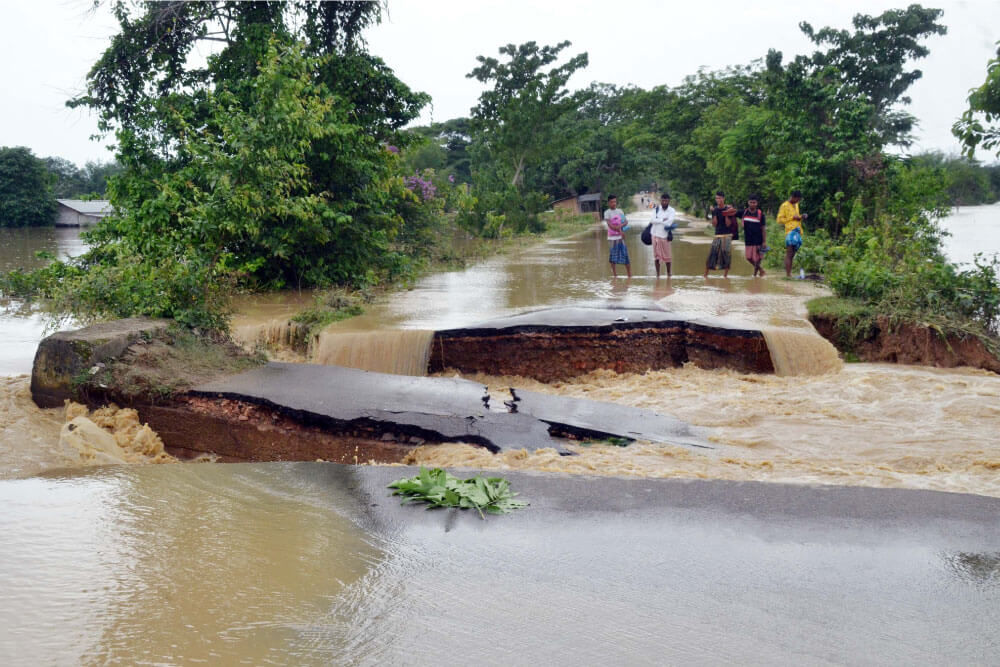
The current washed out a stretch of road in Kathiatoli, in India's Assam district.
Source : Simanta Talukdar, Shutterstock.com
Some populations will have to be displaced, where adaptation is not possible. For example, this is the case for certain islands that will eventually be entirely inundated by rising oceans.
Often, the most vulnerable people are those who don't have the means to adapt. This is the case for certain populations in developing countries. Some of these populations are already struggling to access basic services such as health, education and food aid. At the Paris Agreement, developed countries pledged to give $100 billion each year in international funding towards the global fight against climate change.
To learn more about how to reduce your energy consumption, check out the following links:
The UN site also offers ways to reduce energy consumption specifically in the following areas:
Global warming is accentuating inequalities around the world. Developing countries are not equally affected by the effects of global warming. These countries are often less well prepared and lack the infrastructure needed to cope with the various consequences. The poorest populations are the most vulnerable. If nothing is done to limit the impacts of global warming, nearly 100 million people could find themselves in extreme poverty by 2030[19].
Populations in developing countries are also 5 times more at risk of being displaced after a natural disaster[18]. Between 2010 and 2019, an average of 23.1 million people were displaced each year due to natural phenomena. The majority of them come from developing countries[19].
More people in developing countries live on subsistence farming. Global warming could result in lower agricultural yields, putting these populations at a much higher risk of food insecurity and malnutrition. By 2021, 2.3 billion people worldwide were moderately or severely food insecure[20]. Global warming could increase the number of hungry people by 10-20% by 2050[19].
All of these factors also contribute to intensifying instability in several regions, increasing the risk of conflict.
Subsistence farming is a type of agriculture whose main purpose is to meet the basic food needs of farmers and their families
Over the last few decades, hydroelectric installations as well as the installation of oil pipelines, have caused great concern among Indigenous communities. These installations present major risks that lead to the displacement of populations, pollution of Indigenous territories and negative effects on the health of these populations.

In November 2020, Indigenous activists from the Collectif des Premiers Peuples défenseurs des terres ancestrales demonstrate against the GNL Québec project. The Innu point out that the project would encroach on part of their ancestral lands.
Source : Des membres du Collectif des Premiers Peuples défenseurs des terres ancestrales ont bloqué la voie ferrée pour s’opposer au projet de GNL Québec [Photographie], Radio-Canada, (2020, 5 novembre), (URL). Droits réservés*[21]
Population displacement is one of the biggest issues due to the development of hydroelectric stations. In Quebec, the construction of hydroelectric dams has caused tension between the provincial and federal governments and the Cree, Inuit, and Naskapi communities. In 1971, the provincial government announced the James Bay projects. This created conflict with representatives of the Cree and Inuit communities since they had not been consulted on these projects. The conflict ended in 1975 with the signing of the James Bay and North America Agreement.
Pollution is another problem that affects Indigenous populations living near energy territories. The exploitation of oil sands is a serious concern since it contaminates not only the territory, but also wildlife. As a result, Indigenous populations can no longer hunt because the meat from the animals contains toxic quantities of arsenic. Similarly, the flooding of land caused by hydroelectric projects produces high levels of neurotoxins, like mercury, that contaminate water, soil and animals.
The increase in pollution raises concerns about its impact on the health of Indigenous populations. Residents of the Fort Chipewyan Indigenous community have noted an increase in cancer among community members that is believed to be linked to the exploitation of oil sands [22].
The impact of exploiting these energy resources goes beyond environmental and health issues. It also has major repercussions on the lifestyle and culture of Indigenous populations. Displacement and pollution affect ancestral practices such as hunting, fishing and gathering.
In recent years, the federal and provincial governments have had to be more respectful of Indigenous rights in Canada. This is due to sustained negotiations and ongoing protests by the various Indigenous groups and communities to have their rights recognized. For example, in 2002, the Paix des Braves promised to include Indigenous peoples in decision-making and to respect the ancestral rights of northern Indigenous communities when building hydroelectric facilities. Hydro-Québec made the same promise in 2019.
To access the rest of the unit, please consult the following concept sheets.
- International Energy Agency. (2023). World Energy Outlook 2023. https://iea.blob.core.windows.net/assets/614bb748-dc5e-440b-966a-adae9ea022fe/WorldEnergyOutlook2023.pdf
- Our World in Data. (s.d.). Energy use per person, 2022. https://ourworldindata.org/grapher/per-capita-energy-use?time=latest&country=~BRA
- Régie de l’énergie du Canada. (2022, 31 aout). Aperçu du marché : Raisons pour lesquelles le Canada est l’un des plus grands consommateurs d’électricité au monde. Gouvernement du Canada. https://www.cer-rec.gc.ca/en/data-analysis/energy-markets/market-snapshots/2022/market-snapshot-why-canada-is-one-of-the-worlds-largest-electricity-consumers.html
- Ressources naturelles Canada. (2021-2022). Energy fact book. Gouvernement du Canada.https://natural-resources.canada.ca/sites/nrcan/files/energy/energy_fact/2021-2022/PDF/2021_Energy-factbook_december23_EN_accessible.pdf
- Direction générale du Trésor. (2021, 23 juillet). Le secteur électrique au Nigéria. Ministère de l’économie, des finances et de la souveraineté industrielle et numérique. https://www.tresor.economie.gouv.fr/Articles/2017/11/01/le-secteur-electrique-au-nigeria
- Hydro-Québec. (s.d.). Les produits certifiés ENERGY STAR®. https://www.hydroquebec.com/residentiel/mieux-consommer/certifications-ecoenergetiques.html#tab-electroniques
- Action Climat. (s.d.). Énergies renouvelables – pour un avenir plus sûr. Nations Unies. https://www.un.org/fr/climatechange/raising-ambition/renewable-energy
- Action Climat. (s.d.). L’Accord de Paris. Nations Unies. https://www.un.org/fr/climatechange/paris-agreement
- UNclimatechange. (2015, 30 novembre). Family photo during the Leader Event of COP21/CMP 11 - Paris Climate Change Conference [Photographie]. Flickr. (URL). CC BY 2.0
- L’Organisation mondiale de la Santé. (s.d.). L’effet dévastateur de la pollution de l’air sur la santé. https://www.who.int/fr/news-room/spotlight/how-air-pollution-is-destroying-our-health
- Agence France-Presse. (2021, 9 février). 1 décès sur 5 dans le monde lié à la pollution des énergies fossiles. Radio-Canada. https://ici.radio-canada.ca/nouvelle/1769417/pollution-energies-fossiles-mortalite-monde-asie
- AFP. (2021, 8 février). La pollution liée aux énergies fossiles serait responsable d’un décès sur 5. GEO https://www.geo.fr/environnement/la-pollution-liee-aux-energies-fossiles-serait-responsable-dun-deces-sur-5-203686
- Action Climat. (s.d.). Les villes et la pollution. Nations Unies. https://www.un.org/fr/climatechange/climate-solutions/cities-pollution
- Srivastava, Abhaya - Agence France-Presse. (2023, 28 novembre). New Delhi mise sur l’ensemencement des nuages pour dissiper la pollution. Le Devoir. https://www.ledevoir.com/monde/asie/802795/new-delhi-mise-ensemencement-nuages-dissiper-pollution
- AFP. (2023, 9 novembre). Il ne fait que pleurer et tousser » : les enfants, premières victimes de la pollution de l’air à New Delhi. GEO. https://www.geo.fr/environnement/il-ne-fait-que-pleurer-et-tousser-les-enfants-premieres-victimes-de-la-pollution-de-lair-a-new-delhi-217480
- Thiagarajan, Kamala. (2022, 20 avril). Environnement : la capitale la plus polluée du monde. BBC News. https://www.bbc.com/afrique/monde-61051644
- Réseau action climat - France. (2023, 20 mars). Synthèse du 6e rapport du GIEC : l’urgence climatique est là, les solutions aussi. https://reseauactionclimat.org/synthese-du-rapport-du-giec-lurgence-climatique-est-la-les-solutions-aussi/
- Oxfam France.(2022, 4 février). Changement climatique : causes, conséquences et solutions. https://www.oxfamfrance.org/climat-et-energie/comprendre-les-changements-climatiques/
- Action Climat. (s.d.). Causes du changement climatique. Nations Unies. https://www.un.org/fr/climatechange/science/causes-effects-climate-change
- Communiqué de presse. (2022, 6 juillet). D’après un rapport de l’ONU, la faim dans le monde progresse et pourrait avoir touché jusqu’à 828 millions de personnes en 2021. Organisation mondiale de la Santé. https://www.who.int/fr/news/item/06-07-2022-un-report--global-hunger-numbers-rose-to-as-many-as-828-million-in-2021
- Radio-Canada. (2020, 5 novembre). Des membres du Collectif des Premiers Peuples défenseurs des terres ancestrales ont bloqué la voie ferrée pour s’opposer au projet de GNL Québec [Photographie]. (URL).*
- Burrows, Leah. (2016, 14 novembre). Human health risks from hydroelectric projects. The Harvard Gazette. https://news.harvard.edu/gazette/story/2016/11/human-health-risks-from-hydroelectric-projects
*Extrait employé par Alloprof conformément à la Loi sur le droit d’auteur dans le cadre d’une utilisation équitable aux fins d’éducation [https://laws-lois.justice.gc.ca/fra/lois/c-42/page-9.html].
